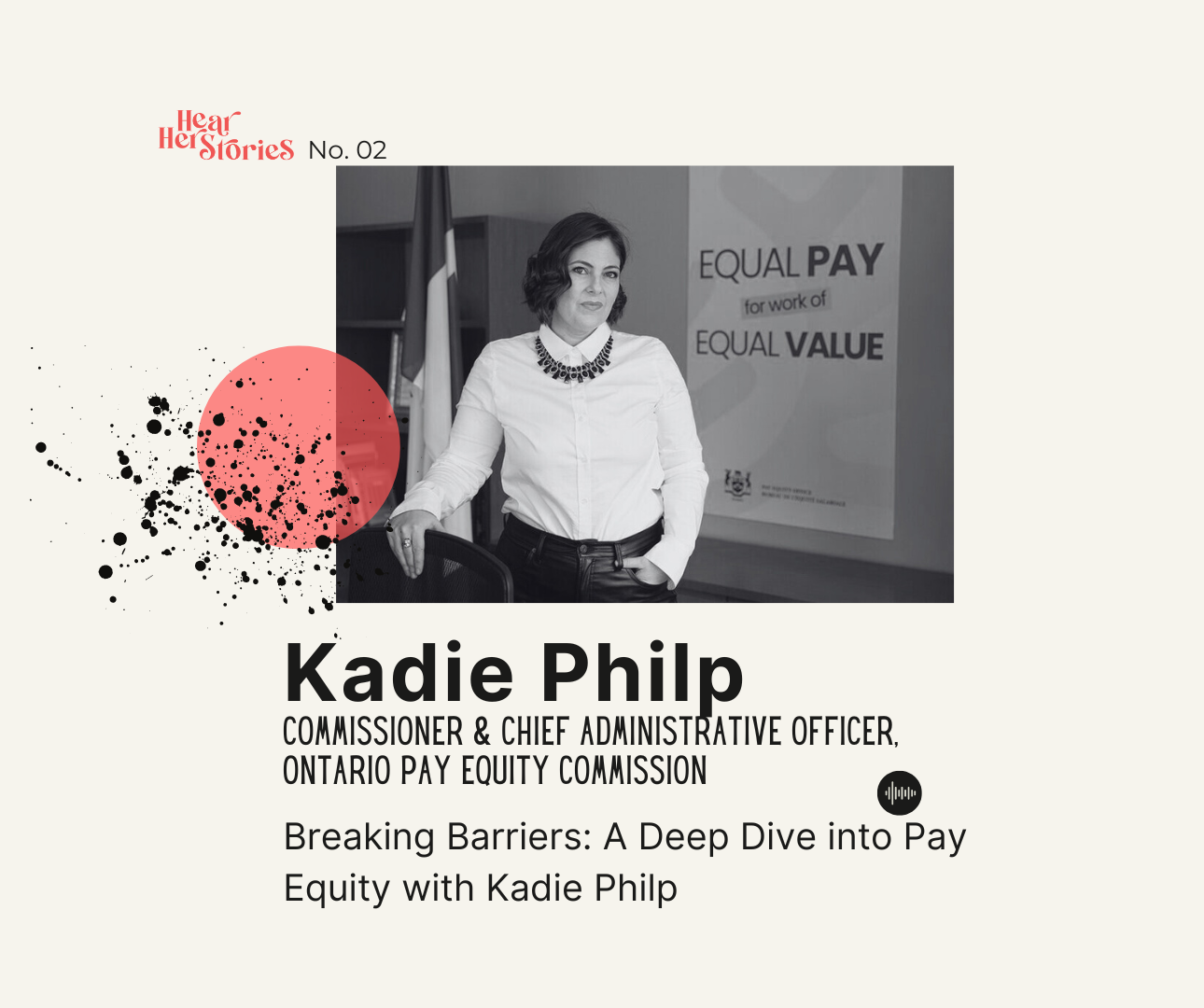
Introduction
In the latest episode of the Hear Her Stories podcast, we had the privilege of hosting Kadie Philp, the Commissioner and Chief Administrative Officer of Ontario’s Pay Equity Commission. Kadie shared invaluable insights on pay equity… what it means, why it matters, and how we can collectively work towards closing the gender wage gap. Our discussion explored Ontario’s progress, challenges employers face, and actionable steps for individuals and organizations to foster equity in the workplace. Here are the highlights from our conversation, along with key takeaways and resources Kadie recommended.
What Is Pay Equity and Why Does It Matter?
Kadie opened the discussion by breaking down the difference between pay equity and equal pay for equal work. She explained that while equal pay ensures that men and women in the same roles are paid equally, pay equity goes a step further by focusing on fair compensation for jobs of equal value, even if the roles are different.
“Pay equity ensures that roles traditionally associated with women, such as caregiving or administrative positions, are valued as highly as roles traditionally associated with men, like technical or managerial positions,” Kadie said.
She stressed that pay equity is more than just a legal requirement—it’s a moral imperative that drives economic equality, improves workplace satisfaction, and reduces turnover.
Ontario’s Progress and the Road Ahead
When asked about Ontario’s journey toward achieving pay equity, Kadie shared both the milestones and the gaps that remain. She highlighted the progress made through legislative frameworks, employer compliance programs, and public education initiatives. However, she acknowledged that challenges persist.
“The largest gaps still exist in sectors where women and marginalized groups are overrepresented, such as caregiving, retail, and hospitality. These are areas where systemic undervaluation of work continues,” Kadie noted.
She pointed out that the COVID-19 pandemic exposed and exacerbated existing disparities, making the need for pay equity more urgent than ever.
Challenges Employers Face
Kadie candidly discussed the hurdles that organizations, especially small to medium-sized businesses, face in implementing pay equity measures. These include a lack of awareness about their obligations, limited resources to conduct job evaluations, and misconceptions about the cost of compliance.
“Pay equity isn’t just an expense; it’s an investment in your workforce,” Kadie emphasized. “It builds trust, enhances productivity, and creates a stronger workplace culture.”
She encouraged employers to tap into the resources offered by the Ontario Pay Equity Office, which include training programs, toolkits, and how to contact the Pay Equity Office for support and guidance.
The Intersectionality of Pay Equity
Kadie also shed light on how pay equity intersects with race, disability, and immigrant status. Women from marginalized communities often face compounded disadvantages, making the wage gap even wider for them.
“For racialized women, women with disabilities, and immigrant women, the barriers to pay equity are systemic and multifaceted,” Kadie explained. “Addressing these disparities requires a commitment to intersectionality—ensuring that no one is left behind in the fight for equity.”
She stressed that targeted policies and programs are essential to address the unique challenges these populations face.
The Role of Public Awareness
Public awareness, Kadie shared, plays a pivotal role in advancing pay equity. Conversations like those on the Hear Her Stories podcast amplify the issue, dispelling myths and educating both employers and employees.
“One of the biggest misconceptions about pay equity is that it’s only a women’s issue. In reality, it benefits everyone by creating a more equitable and productive society,” Kadie said.
She encouraged individuals to become advocates for pay equity by starting conversations, seeking resources, and holding their organizations accountable.
Advice for Individuals
Kadie provided practical advice for individuals who feel they are not being compensated fairly. She suggested starting with the following steps:
Research: Understand your organization’s pay structure and relevant laws in Ontario.
Document: Gather evidence of pay disparities, such as job descriptions, performance reviews, and salary details.
Speak Up: Approach your employer or HR department with your concerns and request a review.
“You have the right to equitable pay. Don’t be afraid to advocate for yourself,” Kadie encouraged.
Kadie’s Personal Journey and Advice for Women
Toward the end of the podcast, Kadie shared her personal motivation for championing pay equity. She reflected on experiences where she witnessed the impact of wage disparities and how those moments shaped her commitment to this work.
Her advice for young women entering the workforce was both empowering and practical:
“Know your worth. Research your industry standards, don’t hesitate to negotiate, and always advocate for yourself and others.”
Key Resources from the Pay Equity Commission
Kadie emphasized the wealth of resources available to support individuals and organizations in understanding and implementing pay equity:
Pay Equity Office Website: A comprehensive platform offering educational materials, compliance guides, and practical tools for employers and employees alike.
Training Programs: Accessible workshops and webinars designed to equip businesses of all sizes with the knowledge they need to achieve compliance and promote equitable practices.
For more details, the Pay Equity Office website is packed with resources, reports, and actionable guidance to help you stay informed and take meaningful steps toward pay equity. The road to true pay equity is long, but together, we can close the gap and create a fairer future for everyone.
Conclusion
Our conversation with Kadie left us inspired and informed about the critical importance of pay equity. It’s not just about closing the wage gap, it’s about creating a fairer, more inclusive society for everyone. As Kadie reminded us, each of us has a role to play, whether it’s advocating for ourselves, supporting our colleagues, or driving change in our organizations.
We hope this podcast sparks conversations and action. For more insights, listen to the full episode and explore the resources provided by the Ontario Pay Equity Commission. Together, we can move closer to a future where everyone’s work is valued equally.
